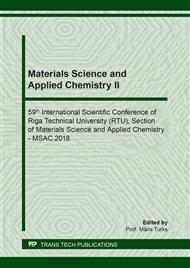[1]
H. Lata, V.K. Garg, R.K. Gupta, Sequestration of nickel from aqueous solution onto activated carbon prepared from Parthenium hysterophorus, L. J. Hazard. Mater. 157 (2008) 503-509.
DOI: 10.1016/j.jhazmat.2008.01.011
Google Scholar
[2]
P. Xiangliang, W. Jianlong, Z. Daoyong, Biosorption of Pb(II) by Pleurotus ostreatus immobilized in calcium alginate gel, Process Biochem. 40 (2005) 2799-2803.
DOI: 10.1016/j.procbio.2004.12.007
Google Scholar
[3]
M. Kobya, E. Demirbas, E. Senturk, M. Ince, Adsorption of heavy metal ions from aqueous solutions by activated carbon prepared from apricot stone, Bioresour. Technol. 96 (2005) 1518-1521.
DOI: 10.1016/j.biortech.2004.12.005
Google Scholar
[4]
A.H. Oren, A. Kaya, Factors affecting adsorption characteristics of Zn2+ on two natural zeolites, J. Hazard. Mater. B. 131 (2006) 59-65.
DOI: 10.1016/j.jhazmat.2005.09.027
Google Scholar
[5]
A. Iddou and M.S. Ouali, Waste-activated sludge (WAS) as Cr(III) sorbent biosolid from wastewater effluent, Colloids Surfaces B Biointerfaces. 66 (2008) 240-245.
DOI: 10.1016/j.colsurfb.2008.06.018
Google Scholar
[6]
N. Noureddine, S. Benhammadi, F. Kara, H. Aguedal, A. Iddou, T. Juhna, Purification of contaminated water with chromium(VI) using Pseudomonas aeruginosa, Key Eng. Mater. 721 (2017) 143-148.
DOI: 10.4028/www.scientific.net/kem.721.143
Google Scholar
[7]
H. Yuan, J. Zhang, Z. Lu, H. Min, C. Wu, Studies on biosorption equilibrium and kinetics of Cd2+ by Streptomyces sp. K33 and HL-12, Journal of Hazardous Materials. 164 (2009) 423-431.
DOI: 10.1016/j.jhazmat.2008.08.014
Google Scholar
[8]
L. Svecova, M. Spanelova, M. Kubal, E. Guibal, Cadmium, lead and mercury biosorption on waste fungal biomass issued from fermentation industry, I. Equilibrium studies, Separation and Purification Technology. 52 (2006) 142-153.
DOI: 10.1016/j.seppur.2006.03.024
Google Scholar
[9]
Y. Dursun, A comparative study on determination of the equilibrium, kinetic and thermodynamic parameters of biosorption of copper (II) and lead(II) ions onto pretreated Aspergillus niger, Biochemical Engineering Journal. 28 (2006) 187-195.
DOI: 10.1016/j.bej.2005.11.003
Google Scholar
[10]
G. Yan, T. Viraraghavan, Heavy metal removal from aqueous solution by fungus Mucor rouxii, Water Res. 37 (2003) 4468-4496.
DOI: 10.1016/s0043-1354(03)00409-3
Google Scholar
[11]
Q. Li, S. Wu, G. Liu, X. Liao, X. Deng, D. Sun,Y. Hu,Y. Huang, Simultaneous biosorptionof cadmium(II) and lead(II) ions by pretreated biomass of Phanerochaete chrysosporium, Separ. Purif. Technol. 34 (2004) 135-142.
DOI: 10.1016/s1383-5866(03)00187-4
Google Scholar
[12]
D. Kratochvil, B. Volesky, Advances in biosorption of heavy metals, Trends Biotechnol. 16 (1998) 291-300.
Google Scholar
[13]
K. Vijayaraghavan, M. Lee, Y. Yun, Evaluation of fermentation waste (Corynebacterium glutamicum) as a biosorbent for the treatment of nickel(II) bearing solutions, Biochemical Engineering Journal. 41 (2008) 228-233.
DOI: 10.1016/j.bej.2008.04.019
Google Scholar
[14]
R. Nadeem, T.M. Ansari, A.M. Khalid, Fourier Transform Infrared Spectroscopic characterization and optimization of Pb(II) biosorption by fish (Labeo rohita) scales, Journal of Hazardous Materials. 156 (2008) 64-73.
DOI: 10.1016/j.jhazmat.2007.11.124
Google Scholar
[15]
R.A. Anayurt, A. Sari, M. Tuzen, Equilibrium, thermodynamic and kinetic studies on biosorption of Pb(II) and Cd(II) from aqueous solution by macrofungus (Lactarius scrobiculatus) biomass, Chemical Engineering Journal. 151 (2009) 255-261.
DOI: 10.1016/j.cej.2009.03.002
Google Scholar
[16]
A. Sarı, M. Tuzen, Biosorption of Pb(II) and Cd(II) from aqueous solution using green alga (Ulva lactuca) biomass, J. Hazard. Mater. 152 (2008) 302-308.
DOI: 10.1016/j.jhazmat.2007.06.097
Google Scholar
[17]
S. Tunali, T. Akar, A.S. Ozcan, I. Kiran, A. Ozcan, Equilibrium and kinetics of biosorption of lead(II) from aqueous solutions by Cephalosporium aphidicola, Separ. Purif. Technol. 47 (2006) 105-112.
DOI: 10.1016/j.seppur.2005.06.009
Google Scholar
[18]
T. Akar, S. Tunali, Biosorption characteristics of Aspergillus flavus biomass for removal of Pb(II) and Cu(II) ions from an aqueous solution, Bioresour. Technol. 97 (2006) 1780-1787.
DOI: 10.1016/j.biortech.2005.09.009
Google Scholar
[19]
B. Mattuschka, G. Straube, Biosorption of metals by a waste biomass, J. Chem. Technol. Biotechnol. 58 (1993) 57-63.
DOI: 10.1002/jctb.280580108
Google Scholar
[20]
R.J.E. Martins, R. Pardo, R.A.R. Boaventura, cadmium(II) and zinc(II) adsorption by the aquatic moss Fontinalis antipyretica: effect of temperature, pH and water hardness, Water Res. 38 (2004) 693-699.
DOI: 10.1016/j.watres.2003.10.013
Google Scholar


